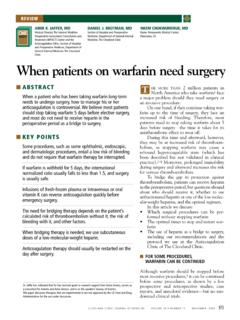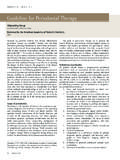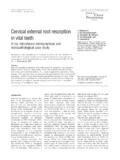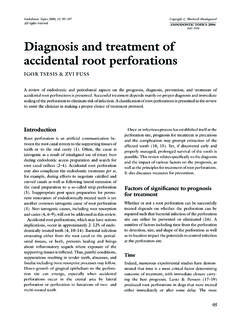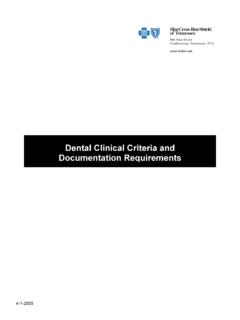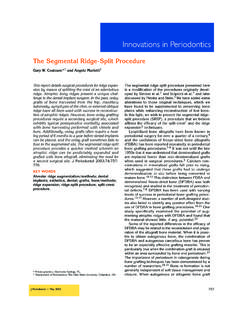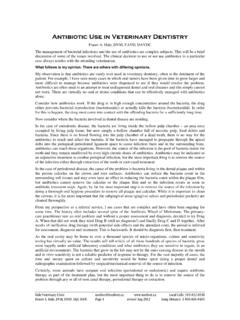Transcription of Association between periodontal diseases and ... - …
1 Oral Health32 Braz Oral Res 2008;22(Spec Iss 1):32-43 Association between periodontal diseases and systemic diseasesAbstract: Current evidence suggests that periodontal disease may be as-sociated with systemic diseases . This paper reviewed the published data about the relationship between periodontal disease and cardiovascular diseases , adverse pregnancy outcomes, diabetes and respiratory diseases , focusing on studies conducted in the Brazilian population. Only a few studies were found in the literature focusing on Brazilians (3 concerning cardiovascular disease, 7 about pregnancy outcomes, 9 about diabetes and one regarding pneumonia). Although the majority of them observed an Association between periodontitis and systemic conditions, a causal relationship still needs to be demonstrated. Further studies, particular-ly interventional well-designed investigations, with larger sample sizes, need to be conducted in Brazilian : Periodontitis; Cardiovascular diseases ; Pregnancy complications; Diabetes mellitus; Lung cia Weidlich(a) Renata Cim es(b) Claudio Mendes Pannuti(c) Rui Vicente Oppermann(d) (a) PhD Student; (d)Dean Department of Periodontology, Federal University of Rio Grande do Sul, Brazil.
2 (b) PhD, Department of Prosthodontics and Oral Surgery, Federal University of Pernambuco, Brazil. (c) PhD, Discipline of Periodontics, School of Dentistry, Ibirapuera University, S o Paulo, HealthCorresponding author: Claudio Mendes Pannuti Faculdade de Odontologia Universidade de S o Paulo (FOUSP) Departamento de Periodontia Av. Prof. Lineu Prestes, 2227 Cid. Universit ria S o Paulo - SP - Brazil CEP: 05508-000 E-mail: for publication on Jun 11, 2008 Accepted for publication on Jun 25, 2008 Weidlich P, Cim es R, Pannuti CM, Oppermann RV33 Braz Oral Res 2008;22(Spec Iss 1):32-43 DisclosuresThis article was sponsored by an educational grant from Johnson & Johnson do Brasil Ind stria e Com rcio para Sa de understanding of the etiology and patho-genesis of periodontal diseases and their chronic, inflammatory and infectious nature1 necessitates admitting the possibility that these infections may influence events elsewhere in the body.
3 At the same time, recognition of the interaction between oral dis-eases and some systemic conditions entails that den-tists and periodontists should direct their practice and knowledge not only to events strictly related to the oral cavity but also consider systemic conditions and diseases which may change or interfere with es-tablished preventive and therapeutic approaches. The concept that oral diseases could influence distant structures is, to a certain extent, a return to the theory of focal infection. The evidence support-ing this theory dates from around 1900 and it was based on the expert opinion and personal clinical experience of a few physicians and dentists. Some reports of questionable scientific merit have also supported the influence of dental sepsis on system-ic The return of this concept since the end of the 80 s has been investigated in a quite differ-ent scenario. Advances in the methods of scientific investigation were undoubtedly decisive in this con-text.
4 The development of epidemiological studies and statistical analysis, the enhanced understanding of biological plausibility by means of advances in molecular biology, microbiology, immunology and genetics, the possibility of successfully treating peri-odontal diseases , caries and endodontic infections and retaining teeth instead of extracting them, all these factors have led dental and medical research-ers and clinicians to resume the study of the rela-tionship between oral diseases and systemic condi-tions with a more scientific paper discusses the relationship between periodontal diseases and the most studied systemic conditions: cardiovascular diseases , adverse preg-nancy outcomes, diabetes mellitus and respiratory diseases . Each section presents the current state of the field, indicates questions to be answered and presents studies performed in Brazilian diseases and cardiovascular diseasesCardiovascular diseases (CVD) are a group of diseases that include congestive heart failure, cardi-ac arrhythmias, coronary artery disease (including atherosclerosis and myocardial infarction), valvular heart disease and stroke.
5 Among these, atheroscle-rosis, a major component of cardiovascular diseases , is characterized by the deposition of atherosclerotic plaques on the innermost layer of walls of large- and medium-sized arteries. End-stage outcomes associ-ated with atherosclerosis include coronary thrombo-sis, myocardial infarction and and periodontitis are both chronic and multifactorial diseases , and share some of their risk factors: age, male gender, lower socioeconomic status, smoking and psychosocial factors such as Recently, periodontal disease (PD) has been investigated as a potential factor contributing to the onset and development of CVD. Several mechanisms that could explain this as-sociation have been investigated. The host response to the presence of periodontal pathogens may trig-ger the production of inflammatory mediators such as C-reactive protein, TNF- , PGE2, IL-1 and IL-6, which can accelerate the progression of pre-ex-isting atherosclerotic plaques4 and are related to an increased number of adverse cardiovascular Also, several studies demonstrated the ability of periodontal pathogens to induce platelet aggrega-tion and the formation of ,7A systematic review published in 20038 studied the evidence supporting the Association between PD and CVD.
6 Thirty-one human studies were selected. The authors concluded that periodontal disease may be modestly associated with atherosclerosis, myocardial infarction and cardiovascular events . Other three systematic reviews9-11 reported a modest but significant Association between CVD and peri-odontal question is whether periodontal treat-ment can decrease the risk for adverse cardiovascu- Association between periodontal diseases and systemic diseases34 Braz Oral Res 2008;22(Spec Iss 1):32-43lar events. However, so far there is limited evidence regarding this question. Cardiovascular events may take several years to occur, so the possible benefits of periodontal therapy are difficult to observe in in-terventional studies. Some investigations reported the effects of periodontal treatment on surrogate endpoints, such as C-reactive protein, which is asso-ciated with However, a recent systematic re-view concluded that, up to now, there is no evidence that periodontal treatment can significantly reduce C-reactive protein studies regarding this Association have been conducted in the Brazilian population.
7 One case- control study and two cross-sectional studies were re-trieved from the Medline and Scielo databases, using the words periodontitis , periodontal , cardiovas-cular , infarction and atherosclerosis (Table 1).The case control study, conducted in South-ern Brazil, found a significant Association between periodontitis and acute coronary One cross-sectional study14 observed significant asso-ciation between periodontal disease and severe ob-struction of coronary artery. However, the authors did not present multivariate analysis with adjust-ment for confounders related to periodontitis and CVD. The other cross-sectional study15 did not present a multivariate analysis to investigate the as-sociation between the two conditions, and reported that periodontal disease was elevated in patients with Ischemic Coronary Atherosclerosis. Some po-tential methodological biases should be considered in order to avoid erroneous conclusions about a causal relationship between periodontal disease and adverse cardiovascular events in these populations.
8 The criteria adopted to define periodontal disease exposure in these studies must also be carefully analyzed. More interventional studies, with larger sample sizes, need to be conducted in the Brazilian pregnancy outcomes and periodontal diseasesThis section will focus particularly on the rela-tionship between periodontal diseases and preterm birth and low birth weight, which has been exten-sively studied in last years all over the world. The first study to report the influence of poor oral health on the birth of low weight and preterm infants was performed by Offenbacher and They obtained obstetric and demographic information from the studied patients prenatal re-cords and performed full mouth periodontal exam-inations in 93 mothers who gave birth to preterm or low weight infants and compared them to those of 31 mothers who had term deliveries and normal weight infants.
9 Multivariate analysis showed that the women with more than 60% of sites with clini-cal attachment loss of 3 mm or more were seven Table 1 - Studies assessing the relationship between periodontal disease and cardiovascular diseases in Brazilian popula-tions. AuthorsStudy designPopulationPeriodontal outcome or exposureCardiovascular disease outcomeFindings and conclusionsAccarini, de Godoy14 (2006)Cross-Sectional361 patients from a Hospital in S o Paulo (SP)30% of sites with clinical attachment level and/or periodontal pocket depth 5 mmSevere obstruction of coronary artery (at least one obstruction 50%)Significant Association between periodontal disease and severe obstruction of coronary artery (OR , CI )Barilli et (2006)Cross-Sectional634 patients from a Hospital in Ribeir o Preto (SP)Presence of periodontal disease according to Community periodontal IndexIschemic Coronary Atherosclerosis periodontal disease was elevated in patients with Ischemic Coronary AtherosclerosisRech et (2007)Case-control58 cases (acute coronary syndrome) and 57 matched controls from a hospital in Gravata (RS)
10 Presence of periodontal pockets, attachment loss and gingival inflammationPresence of acute coronary syndromeSignificant Association between periodontitis and acute coronary syndrome (OR CI )Weidlich P, Cim es R, Pannuti CM, Oppermann RV35 Braz Oral Res 2008;22(Spec Iss 1):32-43times more likely to have an adverse pregnancy out-come than periodontally healthy women (OR = ; CI ). The etiology of preterm birth is multifactorial, but inflammation is the common pathway that leads to uterine contractions and cervical changes with or without premature rupture of membranes. Inflam-mation associated to preterm birth can be mainly attributable to intrauterine infection and bacterial vaginosis, and the latter accounts for up to 40% of the cases of spontaneous preterm labor and preterm birth. There is also a causal relationship between bacterial vaginosis and preterm birth18 and the pres-ence of significantly higher levels of proinflamma-tory cytokines and prostaglandins in the amniotic fluid.










